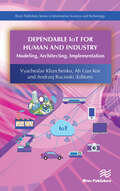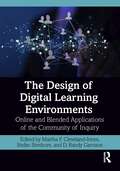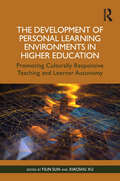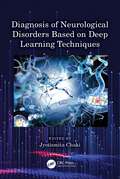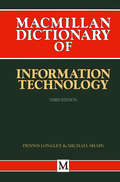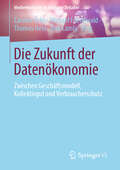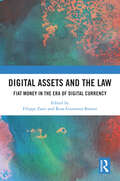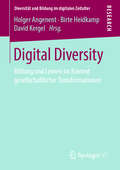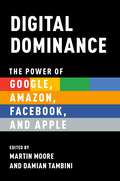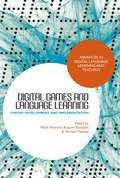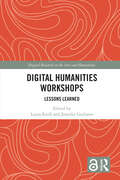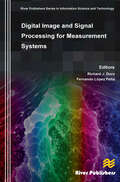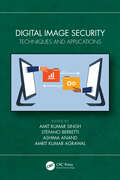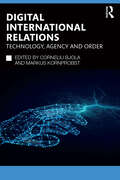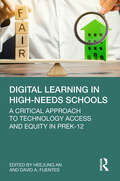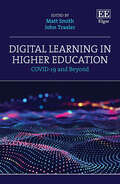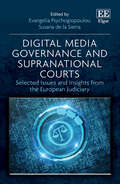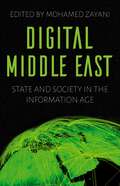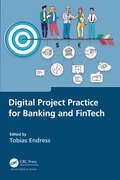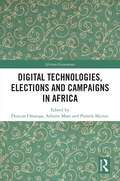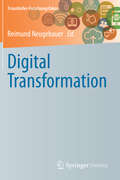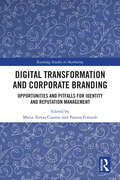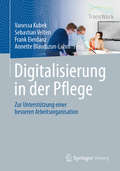- Table View
- List View
Dependable IoT for Human and Industry: Modeling, Architecting, Implementation
There are numerous publications which introduce and discuss the Internet of Things (IoT). In the midst of these, this work has several unique characteristics which should change the reader’s perspective, and in particular, provide a more profound understanding of the impact of the IoT on society. Dependable IoT for Human and Industry covers the main aspects of Internet of Things and IoT based systems such as global issues of applications, modeling, development and implementation of dependable IoT for different human and industry domains. Technical topics discussed in the book include: Introduction in Internet of vital and trust Things Modelling and assessment techniques for dependable and secure IoT systems Architecting and development of IoT systems Implementation of IoT for smart cities and drone fleets; business and blockchain, transport and industry Training courses and education experience on Internet and Web of ThingThe book contains chapters which have their roots in the International Conference IDAACS 2017, and Workshop on Cyber Physical Systems and IoT Dependability CyberIoT-DESSERT 2017.
The Design of Digital Learning Environments: Online and Blended Applications of the Community of Inquiry
The Design of Digital Learning Environments provides comprehensive guidelines for creating and delivering high-quality online and blended learning experiences in higher education. With increasing numbers of students engaged in partially or fully digital education, graduate students preparing for design, development, or faculty roles need fresh, practical applications of cutting-edge research and theory. This textbook uses the Community of Inquiry framework, an influential and invaluable pedagogical model focused on deep learning, to aid educators in forging meaningful, collaborative connections with students engaged in digitally supported multi-modal learning in colleges and universities, MOOCs, and lifelong learning initiatives. Across five parts, the book covers the basic structure, concepts, terminology, and history of the Community of Inquiry; principles for designing and delivering digital courses; design for specific course conditions; applications of learning activities guided by the framework; and current limitations and directions for further research.
The Development of Personal Learning Environments in Higher Education: Promoting Culturally Responsive Teaching and Learner Autonomy
The Development of Personal Learning Environments in Higher Education explores how today’s knowledge-based, learner-centered virtual platforms, which often limit teaching to a complimentary facilitation role, can compromise with the requirements and regulations of colleges and universities. Personal Learning Environments (PLEs) driven by culturally responsive teaching and learner autonomy represent a shift in the higher education paradigm, but how can scholars, designers, administrators, and faculty ensure effective, institutionally compatible construction and management of these systems? This book offers forward-thinking insights into the variety of student-centered learning interactions, particularly culturally and linguistically responsive pedagogies, that can be integrated into PLEs. Attending to quality assessment rubrics, the nuances of stakeholders’ needs, and theoretically sound frameworks, these cross-cultural, interdisciplinary chapters explore how leaders, instructors, technologists, and learners can form a precise yet flexible ecosystem to fully realize PLEs in which co-created, intercultural narratives yield rich, relevant digital learning experiences.
Diagnosis of Neurological Disorders Based on Deep Learning Techniques
This book is based on deep learning approaches used for the diagnosis of neurological disorders, including basics of deep learning algorithms using diagrams, data tables, and practical examples, for diagnosis of neurodegenerative and neurodevelopmental disorders. It includes application of feed-forward neural networks, deep generative models, convolutional neural networks, graph convolutional networks, and recurrent neural networks in the field of diagnosis of neurological disorders. Along with this, data preprocessing including scaling, correction, trimming, and normalization is also included. Offers a detailed description of the deep learning approaches used for the diagnosis of neurological disorders. Demonstrates concepts of deep learning algorithms using diagrams, data tables, and examples for the diagnosis of neurodegenerative, neurodevelopmental, and psychiatric disorders. Helps build, train, and deploy different types of deep architectures for diagnosis. Explores data preprocessing techniques involved in diagnosis. Includes real-time case studies and examples. This book is aimed at graduate students and researchers in biomedical imaging and machine learning.
Dictionary of Information Technology (Dictionary Series)
A dictionary of information technology containing over 7800 entries, which attempts to explain data processing, communications, office systems, information systems, micro-electronics, graphics, printing and consumer electronics. Over 150 diagrams accompany the text for further clarity.
Die Zukunft der Datenökonomie: Zwischen Geschäftsmodell, Kollektivgut und Verbraucherschutz (Medienkulturen im digitalen Zeitalter)
Digitale Daten gelten sowohl als Quelle für Wirtschaftswachstum, Innovation und Arbeitsplätze wie auch als Treiber der datenbasierten Reorganisation praktisch aller gesellschaftlichen Bereiche („Datafizierung“). Die datenökonomisch befeuerten Transformationsprozesse des Sozialen werfen dementsprechend vielfältige Fragen auf: Welche Daten sollen von wem wie verwertbar sein? Wie lässt sich legitime Verfügungsmacht gestalten? Usw. Der Band behandelt diese Fragen aus interdisziplinärer Perspektive.
Digital Assets and the Law: Fiat Money in the Era of Digital Currency (Routledge-Giappichelli Studies in Law)
This book delves into the intricacies of digital assets. With the increasing reliance on crypto and the potential adoption of digital currencies by central banks, our monetary system is at a critical point. The importance of taking the next step has become even more stringent, as evidenced by this systematic scientific reconstruction. Divided into five concentric parts, the book starts with a historical, technical and financial introduction to digital assets. It then explores the changing role of central banking and monetary economics in the upcoming era. Finally, it focuses on the broad legal issues arising from the new digital landscape, not shying away from exploring forward-thinking solutions and policies for the future. With the contributions of prominent international experts in the field, this collection supplies a transdisciplinary analysis based on the belief that complex phenomena can only be handled by complex solutions. This groundbreaking work aims to be more than just an academic treatise; it is a must-read for students, scholars, financial professionals, and all those who want to understand the emerging digital currency reality that many have yet to fully recognise.
Digital Diversity: Bildung und Lernen im Kontext gesellschaftlicher Transformationen (Diversität und Bildung im digitalen Zeitalter)
Vor dem Hintergrund kultureller Diversität und dem medialen Wandel ergibt sich die Herausforderung, die Begriffe Bildung und Lernen theoretisch zu diskutieren und deren Anforderungsprofile im Kontext pädagogischer Praxis neu auszuloten. Der Sammelband thematisiert feldübergreifend in den Bereichen Erwachsenenbildung, Soziale Arbeit, Medienpädagogik und Hochschulbildung die Effekte der Digitalisierung und zeigt auf, wie ein diversitätssensibler Umgang mit Bildung und Lernen im Kontext gesellschaftlicher Transformationen gelingen kann.
Digital Dominance: The Power of Google, Amazon, Facebook, and Apple
Across the globe, Google, Amazon, Facebook, Apple and Microsoft have accumulated power in ways that existing regulatory and intellectual frameworks struggle to comprehend. A consensus is emerging that the power of these new digital monopolies is unprecedented, and that it has important implications for journalism, politics, and society. It is increasingly clear that democratic societies require new legal and conceptual tools if they are to adequately understand, and if necessary check the economic might of these companies. Equally, that we need to better comprehend the ability of such firms to control personal data and to shape the flow of news, information, and public opinion. In this volume, Martin Moore and Damian Tambini draw together the world's leading researchers to examine the digital dominance of technologies platforms and look at the evidence behind the rising tide of criticism of the tech giants. In fifteen chapters, the authors examine the economic, political, and social impacts of Google, Amazon, Facebook, Apple, and Microsoft, in order to understand the different facets of their power and how it is manifested. Digital Dominance is the first interdisciplinary volume on this topic, contributing to a conversation which is critical to maintaining the health of democracies across the world.
Digital Games and Language Learning: Theory, Development and Implementation (Advances in Digital Language Learning and Teaching)
Due to the rapid development of gaming technologies in recent years, there has been a surge of interest in the role that digital games can play in foreign and second language learning. Bringing together innovative research from an international team of contributors, this book provides a comprehensive overview of the use of digital games in computer-assisted language learning (CALL).The book firstly lays the theoretical foundations and outlines various rationales for using digital games, incorporating contemporary theories of second language acquisition. It also explores the development and impact of digital games designed specifically for language learning, giving due consideration to design principles, pedagogical requirements and student health. Chapters then draw on case studies from Europe and Japan to analyse in-game interaction, attitudes and participation in both institutional and out-of-classroom settings. Seamlessly combining theory with practical application, this book outlines recent developments in the field and the direction of future research, and is a valuable resource for instructors, researchers and practitioners who are designing games or looking to use them in their classrooms.
Digital Humanities Workshops: Lessons Learned (Digital Research in the Arts and Humanities)
Digital Humanities Workshops is the first volume to focus explicitly on the most common and accessible kind of training in digital humanities (DH): workshops. Drawing together the experiences and expertise of dozens of scholars and practitioners from a variety of disciplines and geographical contexts, the chapters in this collection examine the development, deployment, and assessment of a workshop or workshop series. In the first section, "Where?", the authors seek to situate digital humanities workshops within local, regional, and national contexts. The second section, "Who?", guides readers through questions of audience in relation to digital humanities workshops. In the third and final section, "How?", authors explore the mechanics of such workshops. Taken together, the chapters in this volume answer the important question: why are digital humanities workshops so important and what is their present and future role? Digital Humanities Workshops examines a range of digital humanities workshops and highlights audiences, resources, and impact. This volume will appeal to academics, researchers and postgraduate students, as well as professionals working in the DH field.
Digital Image and Signal Processing for Measurement Systems
This book provides an overview of advanced digital image and signal processing techniques that are currently being applied in the realm of measurement systems. The book is a selection of extended versions of the best papers presented at the Sixth IEEE International Workshop on Intelligent Data Acquisition and Advanced Computing Systems: Technology and Applications IDAACS 2011 related to this topic and encompass applications that go from multidimensional imaging to evoked potential detection in brain computer interfaces. The objective was to provide a broad spectrum of measurement applications so that the different techniques and approaches could be presented.Digital Image and Signal Processing for Measurement Systems concentrates on signal processing for measurement systems and its objective is to provide a general overview of the area and an appropriate introduction to the topics considered. This is achieved through 10 chapters devoted to current topics of research addressed by different research groups within this area. These 10 chapters reflect advances corresponding to signals of different dimensionality. They go from mostly one dimensional signals in what would be the most traditional area of signal processing realm to RGB signals and to signals of very high dimensionality such as hyperspectral signals that can go up to dimensionalities of more than one thousand. The chapters have been thought out to provide an easy to follow introduction to the topics that are addressed, including the most relevant references, so that anyone interested in this field can get started in the area. They provide an overview of some of the problems in the area of signal and image processing for measurement systems and the approaches and techniques that relevant research groups within this area are employing to try to solve them which, in many instances are the state of the art of some of these topics.
Digital Image Security: Techniques and Applications
This book will highlight cutting-edge research with a particular emphasis on interdisciplinary approaches, novel techniques, and solutions to provide digital image security for applications in diverse areas. It further discusses important topics such as biometric imaging, big data security and privacy in healthcare, security and privacy in the internet of things, and security in cloud-based image processing.This book Presents new ideas, approaches, theories, and practices with a focus on digital image security and privacy solutions for real-world applications. Discusses security in cloud-based image processing for smart city applications. Provides an overview of innovative security techniques that are being developed to ensure the guaranteed authenticity of transmitted, shared, or stored digital images. Highlights approaches such as watermarking, blockchain, and hashing. to secure digital images in artificial intelligence, machine learning, cloud computing, and temper detection environments. Explains important topics such as biometric imaging, blockchain for digital data security, and protection systems against personal identity theft. It will serve as an ideal reference text for senior undergraduate, graduate students, academic researchers, and professionals in the fields including electrical engineering, electronics, communications engineering, and computer engineering.
Digital International Relations: Technology, Agency and Order (Routledge Studies in Conflict, Security and Technology)
This book analyses how digital transformation disrupts established patterns of world politics, moving International Relations (IR) increasingly towards Digital International Relations. This volume examines technological, agential and ordering processes that explain this fundamental change. The contributors trace how digital disruption changes the international world we live in, ranging from security to economics, from human rights advocacy to deep fakes, and from diplomacy to international law. The book makes two sets of contributions. First, it shows that the ongoing digital revolution profoundly changes every major dimension of international politics. Second, focusing on the interplay of technology, agency and order, it provides a framework for explaining these changes. The book also provides a map for adjusting the study of international politics to studying International Relations, making a case for upgrading, augmenting and rewiring the discipline. Theory follows practice in International Relations, but if the discipline wants to be able to meaningfully analyse the present and come up with plausible scenarios for the future, it must not lag too far behind major transformations of the world that it studies. This book facilitates that theoretical journey. This book will be of much interest to students of cyber-politics, politics and technology, and International Relations.
Digital Learning in High-Needs Schools: A Critical Approach to Technology Access and Equity in PreK-12
Digital Learning in High-Needs Schools examines the challenges and affordances that arise when high-needs school communities integrate educational technologies into their unique settings. Although remote, blended, and networked learning are ubiquitous today, a number of cultural, economic, and political realities—from the digital divide and digital literacy to poverty and language barriers—affect our most vulnerable and underresourced teachers and students. This book uses critical theory to compassionately scrutinize and unpack the systemic issues that impact high-needs schools’ implementation of digital learning tools. Incisive sociocultural analyses across fifteen original chapters explore the intersection of society, technology, people, politics, and education in high-needs school contexts. Informed by real-world cases pertaining to technology infrastructure, formative feedback, Universal Design for Learning, and more, these chapters illuminate how best practices emerge from culturally responsive and context-specific foundations.
Digital Learning in Higher Education: COVID-19 and Beyond
Mapping the uncertain landscape of education in the wake of the COVID-19 pandemic, Digital Learning in Higher Education examines how higher education (HE) institutions have moved to widespread digital learning in an effort to maintain the educational experience. The book navigates the possibilities that lie ahead, exploring the beginnings of a new future for HE. Reflections from HE practitioners on this rapid transition to digital and remote learning offer key perspectives on the new online learning mode, as experienced by students, teaching staff, and those in the wider field of education, including learning technologists, librarians, and publishers. Spurred on by the changes in thinking necessitated by the pandemic, the book highlights the possibilities facilitated by online learning, from enhanced inclusivity to making education accessible to wider audiences. It concludes with a proposal for how we might “build back better” and continue to evolve the sector. Timely and comprehensive, this book will support the pedagogical decision-making of HE practitioners both now and in the future. Offering an insight into what the “new normal” of education may soon resemble, it will also be beneficial to HE management and other educational professionals, helping to guide their policy and financial decision-making processes regarding digital technology.
Digital Media Governance and Supranational Courts: Selected Issues and Insights from the European Judiciary
This timely book untangles the digital media jurisprudence of supranational courts in Europe with a focus on the CJEU and the ECtHR. It argues that in the face of regulatory tension and uncertainty, courts can have a strong bearing on the applicable rules and standards of digital media.Chapters written by expert contributors explore the interpretative steps taken by the CJEU and the ECtHR to solve arising legal issues, shedding light on their interpretation and refinement of the applied rules. The book provides fresh insights into the effects of European adjudication on the content and scope of the rules enforced and examines the ways in which the two European courts address the specificities of digitalization and digital media in their rulings. It also addresses the process of defining the constitutional boundaries of digital media and the exercise of rights and freedoms therein, focusing on digital media and the distinct challenges posed by digitalization and digital communication.Digital Media Governance and Supranational Courts will be a key resource for academics and scholars of European and Constitutional law, fundamental rights and digital transformation, as well as for students seeking a better understanding of the contribution of the CJEU and the ECtHR to digital media governance.
Digital Middle East: State and Society in the Information Age
In recent years, the Middle East's information and communications landscape has changed dramatically. Increasingly, states, businesses, and citizens are capitalizing on the opportunities offered by new information technologies, the fast pace of digitization, and enhanced connectivity. These changes are far from turning Middle Eastern nations into network societies, but their impact is significant. The growing adoption of a wide variety of information technologies and new media platforms in everyday life has given rise to complex dynamics that beg for a better understanding. Digital Middle East sheds a critical light on continuing changes that are closely intertwined with the adoption of information and communication technologies in the region. Drawing on case studies from throughout the Middle East, the contributors explore how these digital transformations are playing out in the social, cultural, political, and economic spheres, exposing the various disjunctions and discordances that have marked the advent of the digital Middle East.
Digital Project Practice for Banking and FinTech
New technology and changes in the regulatory framework have had a significant impact; various new players have emerged, and new business models have evolved. API-based ecosystems have become the new normal and collaboration in the financial and banking industry has reached new levels. Digital Project Practice for Banking and FinTech focuses on technology changes in the financial industry and their implications for business practice.A combination of practical experience in the field as well as academic research, the book explores a wide range of topics in the multifaceted landscape of FinTech. It examines the industry’s various dimensions, implications, and potential based on academic research and practice. From project management in the digital era to the regulation and supervision of FinTech companies, the book delves into distinct aspects of this dynamic field, offering valuable insights and practical knowledge. It provides an in-depth overview of various unfolding developments and how to deal with and benefit from them.The book begins by exploring the unique challenges and opportunities project management presents in the digital era. It examines the evolving role of project management and provides strategies for effectively navigating the complexities of digital transformation initiatives. The book then covers such topics as: Financial Technology Canvas, a powerful tool for facilitating effective communication within fintech teams Process automation implementation in the financial sector and related benefits, challenges, and best practices to drive operational efficiency and enhance customer experiences Robotic process automation in financial institutions Cyptoeconomics and its potential implications for the diffusion of payment technologies The efficiency and risk factors associated with digital disruption in the banking sector. At its core, this book is about real-world practice in the digital banking industry. It is a source of different perspectives and diverse experiences from the global financial and banking industry..
Digital Technologies, Elections and Campaigns in Africa (African Governance)
This book looks at how digital technologies are revolutionizing electoral campaigns and democratization struggles in Africa. Digital technologies are giving voice and civic agency to a cross section of African voters, providing important spaces for political engagement and debate. Drawing on cases from Kenya, Uganda, Mozambique, Nigeria, Ethiopia, and Zimbabwe amongst others, this book traces the shifts and tensions in this changing electoral communications landscape. In doing so, the book explores themes such as hate speech and disinformation, decolonisation, surveillance, internet shutdowns, influencers, bots, algorithms, and election observation, and looks beyond Facebook, Twitter, WhatsApp and YouTube to the increasingly important role of visual platforms such as Instagram and TikTok. Particularly highlighting the contribution of African scholars, this book is an important guide for researchers across the fields of African politics, media studies, and electoral studies, as well as to professionals and policymakers in political communication.
Digital Transformation
With the exception of written letters and personal conversations, digital technology forms the basis of nearly every means of communication and information that we use today. It is also used to control the essential elements of economic, scientific, and public and private life: security, production, mobility, media, and healthcare. Without exaggerating it is possible to say that digital technology has become one of the foundations of our technologically oriented civilization.The benefits of modern data technology are so impressive and the potential for future applications so enormous that we cannot fail to promote its development if we are to retain our leading role in the competitive international marketplace. In this process, security plays a vital role in each of the areas of application of digital technology — the more technological sectors are entrusted to data systems technology, the more important their reliability becomes to us.Developing digital systems further while simultaneously ensuring that they always act and respond in the best interests of people is a central goal of the technological research and development propagated and conducted by Fraunhofer.
Digital Transformation and Corporate Branding: Opportunities and Pitfalls for Identity and Reputation Management (Routledge Studies in Marketing)
Technological advances, alongside increasing globalisation and growing awareness of socio-cultural and socio-political issues, are driving corporate branding innovations, and organisations must react and adapt quickly to compete. This book investigates and explores the impact of digital transformation on building corporate branding, identity, and reputation. The book brings together international contributors to provide examples from a wide range of industries and fi rms, including the retailing and agri-food industries, and illustrates the many dimensions of corporate branding and theories, and how they can be aided by digital transformation. It explores the connection of branding with artificial intelligence, social media networks, and technologies 4.0 as well the limitations and challenges they might deliver. Using a combination of theory, primary research findings, and practice, the book offers viewpoints and expertise from multiple regions, appealing to a global audience. This edited collection serves as an importance resource for researchers, scholars, and postgraduate students of marketing, brand management, and corporate communications, and those interested in the emerging relationship with technology.
Digitales Marketing und Management: Revolution vs. Evolution im Marketing
Digitales Marketing und Management wird auf Basis eines neuen Bezugsrahmens konzipiert. Dieser Bezugsrahmen integriert mit Omnichannel-Marketing, Co-Creation, Customer Experience und Customer Journey die Kernelemente eines zeitgemäßen digitalen Marketingansatzes und führt sie im Kundenzentierten Marketing als neuem Basiskonzept zusammen. In diesem Zusammenhang werden Topthemen der aktuellen Diskussion zum digitalen Marketing und Management eingeordnet und in den einzelnen Beiträgen vertieft. Die Beiträge basieren auf umfangreichen Forschungsprojekten (Dissertationen) mit ausgeprägten empirischen Studien, in denen die Themen methodisch aufwändig untersucht werden.
Digitalisierung der Arbeit in der Langzeitpflege als Veränderungsprojekt
Digitale Arbeitsmittel dringen in Arbeitsbereiche vor, in denen sie bislang nur eine untergeordnete Rolle spielten. Die Langzeitpflege ist einer dieser Bereiche, in dem die Arbeit am Menschen und mit dem Menschen im Mittelpunkt steht. Die Akzeptanz digitaler Technik ist daher bei den Beschäftigten in der Pflege voraussetzungsreich. Um Chancen verwirklichen zu können, die in der Technik für gute Arbeit in der Langzeitpflege liegen, bedarf es einer umfassenden Planung, Einführung und Begleitung von Digitalisierungsprojekten. In diesem Band werden zentrale Dimensionen und notwendige Ressourcen des „Veränderungsprojekts Digitalisierung in der Langzeitpflege“ diskutiert. Zu bedenken sind nicht nur technische, ethische, arbeits- und datenschutzrechtliche Aspekte. Zudem sind für die erfolgreiche Integration in den Arbeitsalltag eine vorausschauende Arbeitsorganisation und Kompetenzentwicklung sowie eine partizipative und motivierende Lern- und Führungskultur bedeutend.
Digitalisierung in der Pflege: Zur Unterstützung einer besseren Arbeitsorganisation
Das Buch richtet den Blick systematisch auf jene Ansätze von Digitalisierung, die die Arbeitsorganisation in der Pflege verbessern und dadurch das Potential haben, zu einer höheren Zufriedenheit von Pflegekräften beizutragen.Digitalisierung in der Pflege wird aktuell sehr kontrovers diskutiert. "Werden Pflegekräfte in Zukunft durch Pflegeroboter ersetzt?" Solche und ähnliche Schlagzeilen werfen weitreichende ethische Fragestellungen auf und tragen nicht dazu bei, das Potential, welches Digitalisierung für die Pflegebranche bietet, sichtbar zu machen. Dieses Buch behandelt Ansätze von Digitalisierung, die Pflegekräfte in ihrer alltäglichen Arbeit unterstützen oder auch die Lebensqualität von Pflegebedürftigen erhöhen. Die vorgestellten Ansätze wurden wissenschaftlich fundiert entwickelt und haben sich in der Praxis bewährt. Das Buch zeigt auch auf, wie der Prozess digitaler Transformation in der Pflege erfolgreich umgesetzt werden kann - nämlich in einer Art und Weise, dass die in der Pflege Beschäftigten von Beginn an Gestalter ihres eigenen Veränderungsprozesses sind.Das Kapitel 8 „Nachhaltige Motivation durch wohlbefindensorientierte Gestaltung“ wird auf link.springer.com unter der Creative Commons Namensnennung 4.0 International Lizenz veröffentlicht.
